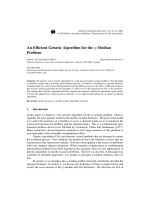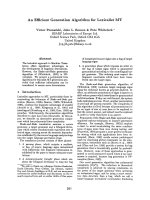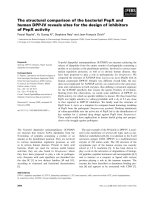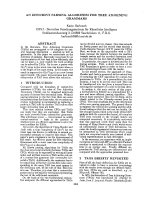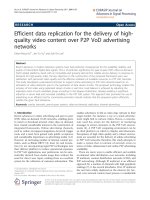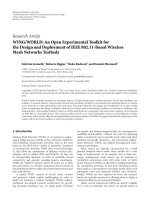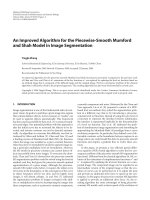Development and implementation of efficient segmentation algorithm for the design of antennas and arrays
Bạn đang xem bản rút gọn của tài liệu. Xem và tải ngay bản đầy đủ của tài liệu tại đây (6.49 MB, 220 trang )
i
DEVELOPMENT AND IMPLEMENTATION OF EFFICIENT
SEGMENTATION ALGORITHM FOR THE DESIGN OF
ANTENNAS AND ARRAYS
ANG IRENE
(B. Eng. (Hons.), NUS)
A THESIS SUBMITTED
FOR THE DEGREE OF DOCTOR OF PHILOSOPHY
DEPARTEMENT OF ELECTRICAL AND COMPUTER
ENGINEERING
NATIONAL UNIVERSITY OF SINGAPORE
2008
i
Acknowledgements
I would like to take this opportunity to express my gratitude to my supervisors
Associate Professor Ooi Ban Leong and Professor Prof. Leong Mook Seng for their
invaluable guidance, constructive criticisms and encouragement throughout the course
of my study. Without their kind assistance and teaching, the progress of this project
would not be possible.
I would like to thank the staff from Microwave Laboratory in the Electrical and
Computing Engineering (ECE) department, especially Mr Sing Cheng Hiong, Mdm
Lee Siew Choo, Mr Jalil and Mr Chan for their kind assistances and support during
the fabrication processes and measurement of the prototypes presented in this thesis. I
would like to thank my friends in Microwave Laboratory, especially Dr Wang Ying,
Miss Zhang Yaqiong, Miss Fan Yijing, Miss Nan Lan, Mr Yu Yan Tao, Mr Zhong
Zheng and Mr Ng Tiong Huat for providing the laughter, encouragement and valuable
help throughout my Ph.D.
Finally, I would like to thank my family and friends. I am very grateful to my parents
for their everlasting supports and encouragement. I would like to express my
appreciation to my mentor cum brother, Mr Chan Hock Soon for teaching me many
ii
valuable life lessons. I wish to express my sincere thanks and appreciation to Heng
Nam for his encouragement, understanding and patience during the completion of this
course.
iii
Table of Contents
ACKNOWLEDGEMENTS I
TABLE OF CONTENTS III
SUMMARY VI
LIST OF FIGURES IX
LIST OF TABLES XV
LIST OF SYMBOLS XVII
LIST OF ACRONYMS XVIII
CHAPTER 1 INTRODUCTION 1
1.1
L
ITERATURE
R
EVIEW AND
M
OTIVATION
1
1.2
S
COPE OF
W
ORK
8
1.3
L
IST OF
O
RIGINAL
C
ONTRIBUTIONS
10
1.4
P
UBLICATIONS
11
CHAPTER 2 NUMERICAL MODELLING OF PLANAR MULTILAYERED
STRUCTURES 13
2.1
I
NTRODUCTION
13
2.2
S
PECTRAL
D
OMAIN
G
REEN
’
S
F
UNCTIONS
[63] 15
2.3
M
IXED
P
OTENTIAL
I
NTEGRAL
E
QUATION
[64] 20
2.4
N
UMERICAL
E
VALUATION OF THE
S
OMMERFELD
I
NTEGRALS
[68]-[71] 22
2.5
D
ISCRETE
C
OMPLEX
I
MAGE
M
ETHOD
[39] 23
2.6
T
HE
M
ETHOD OF
M
OMENTS
[78]-[80] 26
2.6.1 Rooftop Basis Functions 27
2.6.2 RWG Basis Function 28
2.7
D
E
-E
MBEDDING OF
N
ETWORK
P
ARAMETERS
[82] 30
2.8
M
ATCHED
L
OAD
S
IMULATION
[83] 33
2.9
I
NTERPOLATION
S
CHEMES FOR THE
G
REEN
’
S FUNCTION
35
2.9.1 Radial Basis Function [59] 37
2.9.2 Cauchy Method [60]-[61] 38
2.9.3 Generalized Pencil-of-Function Method [56] 40
2.9.4 Numerical Study of the interpolation techniques 41
2.10
F
AR
-
FIELD
R
ADIATION
P
ATTERN
[86] 44
2.11
N
UMERICAL
R
ESULT
45
2.12
C
ONCLUSION
47
CHAPTER 3 MACRO-BASIS FUNCTION 48
iv
3.1
I
NTRODUCTION
48
3.2
M
ACRO
-
BASIS
F
UNCTION
51
3.3
S
UB
-
DOMAIN
M
ULTILEVEL
A
PPROACH
[50] 52
3.4
S
UB
-
ENTIRE
-
DOMAIN
B
ASIS
F
UNCTION
M
ETHOD
[55] 56
3.5
M
ACRO
-
BASIS
F
UNCTION WITH
P
ROGRESSIVE
M
ETHOD
57
3.6 I
TERATIVE
R
EFINEMENT
P
ROCESS
60
3.7 E
FFICIENT EVALUATION OF
M
ACRO
-
BASIS
F
UNCTION
R
EACTION
T
ERM USING
A
DAPTIVE
I
NTEGRAL
M
ETHOD
64
3.8 N
UMERICAL
A
PPLICATIONS TO
F
ILTER AND
A
NTENNA
A
RRAYS
70
3.8.1 Bandpass Filter 71
3.8.2 Linear Series-fed Array 83
3.8.3 Bowtie Dipole Array 95
3.8.4 Design of 24GHz Antenna Array 102
3.8.4.1 Design Procedure 103
3.8.4.2 Simulations and Measurements 108
3.9
C
ONCLUSION
114
CHAPTER 4 DESIGN OF VARIOUS WIDEBAND PROBE-FED
MICROSTRIP PATCH ANTENNAS AND ARRAYS 115
4.1
I
NTRODUCTION
115
4.2
O
VERVIEW OF
W
IDEBAND
P
ROBE
-
FED
M
ICROSTRIP
P
ATCH
A
NTENNA
117
4.2.1 Parasitic Elements [7]-[14] 117
4.2.2 Slotted Patches [15]-[22] 118
4.2.3 Shaped Probes [23]-[26] 119
4.3
W
IDEBAND
S
EMI
-
CIRCLE
P
ROBE
-
FED
M
ICROSTRIP
P
ATCH
A
NTENNAS
120
4.3.1 Semi-circle Probe-fed Rectangular Patch Antenna 120
4.3.2 Semi-circle Probe-fed Stub Patch Antenna 123
4.3.2.1 Antenna Structure 123
4.3.2.2 Simulations and Measurements 125
4.3.2.3 Parametric Study 131
4.3.3 Semi-circle Probe-fed Flower-shaped Patch Antenna 136
4.3.3.1 Antenna Structure 136
4.3.3.2 Simulations and Measurements 137
4.3.4 Semi-circle Probe-fed Pentagon-slot Patch Antenna 145
4.3.4.1 Antenna Geometry 145
4.3.4.2 Simulations and Measurements 145
4.4
S
EMI
-
CIRCLE
P
ROBE
-
FED
M
ICROSTRIP
S
TUB
A
RRAY
153
4.4.1 4 by 4 Semi-circle Probe-fed Microstrip Stub Patch Antenna Array 154
4.4.1.1 Antenna Geometry 154
4.4.1.2 Simulations and Measurements 161
4.4.2 Two-element Linearly-polarized Array 168
4.4.2.1 Antenna Geometry 168
4.4.2.2 Feed Network 169
4.4.3 4 by 4 Linearly-polarized Array 172
4.5
C
ONCLUSION
175
v
CHAPTER 5 CONCLUSIONS AND FUTURE WORK 176
5.1
C
ONCLUSIONS
176
5.2
S
UGGESTIONS FOR
F
UTURE
W
ORK
179
REFERENCES 181
APPENDIX A TRANSMISSION LINE GREEN’S FUNCTION 195
APPENDIX B METHOD OF AVERAGES 200
vi
Summary
The method of moments (MoM) is a common numerical technique for solving
integral equations. However, the method generates dense matrix which is
computationally expensive to solve, and this limits the complexity of problems which
can be analyzed. To reduce the computational cost of the method of moments,
iterative solvers are employed to solve the dense matrix. However, iterative solvers
may lead to convergence difficulties in dealing with large scale objects. In order to
overcome the convergence issue, segmentation techniques, which can significantly
reduce the number of unknowns, are used to analyze large structures. The focus of
this thesis is to develop improved segmentation method for effective simulation of
large scale problems. This is achieved by combining macro-basis function with
progressive method coupled with adaptive integral method.
In this thesis, spatial domain MoM is used to analyze planar structures. The spatial
domain Green’s functions are evaluated by the discrete complex image method.
Interpolation scheme is required to further reduce the computation time to calculate
the Green’s function. Different interpolation schemes, namely the radial basis function,
the Cauchy method and the generalized pencil-of-function method are investigated
and compared. Of these, the generalized pencil-of-function interpolation scheme
vii
provides the best accuracy with the less number of interpolation points.
In the sub-domain multilevel approach, the mutual coupling between different
portions of the geometry is not directly accounted for during the construction of the
macro-basis function. In turn, this will affect the accuracy of the sub-domain
multilevel approach, especially for dense and complex structure. In order to improve
the accuracy of the solution, a new grouping concept of near-far neigbhour evaluation
called the macro-basis function with progressive method (MBF-PM) is developed in
this thesis. For a chebyshev bandpass filter, the relative error of the current computed
from the macro-basis function with progressive method is 6.4% while the relative
error of the current computed from the sub-domain multilevel approach is 22.9%.
Thus, compared to the sub-domain multilevel approach, better accuracy has been
achieved.
To further improve the accuracy of the solution, a new iterative refinement process,
which utilizes the concept of the macro-basis function, is introduced. Compared to the
reported iterative refinement process in [1], the computation complexity of the new
iterative refinement process is reduced. Compared to the reported iterative refinement
process in [2], better convergence is achieved.
Even though the macro-basis function with progressive method has drastically
reduced the memory requirements and the computation time, the calculation of the
viii
interactions between the macro-basis functions remains the most time-consuming part
of the procedure. In order to speed up the matrix filling time, the adaptive integral
method is integrated into the macro-basis function with progressive method. Some
numerical examples are conducted to examine the performance of this new hybrid
scheme, the macro-basis function with progressive and adaptive integral method
(MBF-PM-AIM). It is demonstrated that for a 1 by 14 antenna array, MBF-PM-AIM
is 10 times faster than the conventional MoM. For a 20 by 20 antenna array with
87780 unknowns, MBF-PM-AIM has achieved a reduction of computer time by a
factor of approximately 60 as compared to the commercial software, IE3D.
After developing the segmentation technique, MBF-PM-AIM is applied to the design
of broadband probe-fed antennas and arrays. Due to the growing demand of modern
wireless communication systems, there is a need to enhance the impedance bandwidth
of the antennas. In this thesis, various wideband semi-circle probe-fed antennas and
arrays are developed for wireless local area network. These include the semi-circle
probe-fed stub patch antenna, the semi-circle probe-fed flower-shaped patch antenna
and the semi-circle probe-fed pentagonal-slot patch antenna. The antennas have been
fabricated and the simulated results are in good agreement with the measured results.
Among the three antennas studied, the semi-circle probe-fed stub patch antenna gives
the best performance with an impedance bandwidth of 68.3%, a 3 dB gain bandwidth
of 45.5% and a broadside gain of 7.07 dBi at 5.4 GHz.
ix
List of Figures
F
IG
2.1:
A
N ARBITRARY SHAPED SCATTERER EMBEDDED IN LAYERED DIELECTRIC
MEDIUM
15
F
IG
2.2:
R
OTATED SPECTRUM
-
DOMAIN COORDINATE SYSTEM
. 17
F
IG
2.3:
C
OMPARISON OF THE CALCULATION FOR
G
Q
USING
DCIM
AND NUMERICAL
INTEGRATION
(M
ETHOD OF
A
VERAGES
)
ON SUBSTRATE WITH H
=1.0
MM
,
Ε
R
=12.6
AT
F
=30GH
Z
. 25
F
IG
2.4:
X-
DIRECTED ROOFTOP BASIS FUNCTION WITH THE CURRENT AND CHARGE CELLS
.
27
F
IG
2.5:
RWG
BASIS FUNCTION
29
F
IG
2.6:
1
CELL ALONG THE TRANSVERSE DIRECTION OF THE FEEDLINE
. 31
F
IG
2.7:
M
ULTIPLE CELLS ALONG THE TRANSVERSE DIRECTION OF THE FEEDLINE
32
F
IG
2.8:
I
LLUSTRATION OF MATCHED LOAD TERMINATION
. 34
F
IG
2.10:
C
OMPARISON OF THE
CPU
TIME USED IN THE DIRECT COMPUTATION OF THE
CLOSED
-
FORM
G
REEN
’
S FUNCTION AND THE
GPOF
INTERPOLATION SCHEME WITH
RESPECT TO THE NUMBER OF
G
REEN
’
S FUNCTIONS EVALUATED
44
F
IG
2.11:
M
ICROSTRIP PATCH ANTENNA WITH SUBSTRATE HEIGHT
=
31
MILS AND Ε
R
=
2.33
AT RESONANT FREQUENCY
2.5
GH
Z
45
F
IG
2.12:
C
OMPARISON OF THE MAGNITUDE AND PHASE OF THE RETURN LOSS OF A LONG
PATCH ANTENNA BETWEEN THE WRITTEN CODE AND
IE3D. 46
F
IG
.
3.1:
I
LLUSTRATION OF SUB
-
DOMAIN MULTILEVEL APPROACH
.
(
A
)
N
ON
-
IDENTICAL
PROBLEM
(
B
)
I
DENTICAL PROBLEM
52
F
IG
.
3.2:
I
LLUSTRATION OF SUB
-
ENTIRE
-
DOMAIN BASIS FUNCTION METHOD
. 56
F
IG
.3.3:
I
LLUSTRATION OF MACRO
-
BASIS FUNCTION WITH PROGRESSIVE METHOD
. 58
F
IG
.3.4:
E
XTENDED REGION OF THE ROOT DOMAIN
59
F
IG
.3.5:
I
TERATIVE
R
EFINEMENT
P
ROCESS
.
(
A
)
I
TERATIVE PROCESS
A.
(
B
)
I
TERATIVE
PROCESS
B 61
F
IG
.3.6:
T
RANSLATION OF ROOFTOP BASIS FUNCTION TO THE HIGHLIGHTED
RECTANGULAR GRIDS
65
F
IG
3.7:
F
LOW CHART FOR ANALYZING A LARGE PROBLEM USING THE DEVELOPED
ALGORITHM
(MBF-PM-AIM) 69
F
IG
3.8:
P
HOTOGRAPH OF THE FABRICATED
C
HEBYSHEV BANDPASS FILTER
. 71
F
IG
.3.9:
C
HEBYSHEV
B
ANDPASS
F
ILTER
.
(
A
)
L
AYOUT OF THE BANDPASS FILTER
.
(
B
)
S
MALL DOMAIN OF THE BANDPASS FILTER
.
L=22.45,
W=1.27,
G
1
=0.254,
G
2
=1.17
AND
G
3
=1.32.
A
LL DIMENSIONS ARE GIVEN IN MM
. 73
F
IG
.3.10:
C
OMPARISON OF THE INITIAL CURRENT ON THE BANDPASS FILTER UNDER
VARIOUS METHODS
:
MACRO
-
BASIS FUNCTION WITH PROGRESSIVE METHOD
x
(MBF-PM),
SUB
-
DOMAIN MULTILEVEL APPROACH
(SMA),
SUB
-
ENTIRE
-
DOMAIN
(SED)
AND CONVENTIONAL
M
O
M 74
F
IG
.3.11:
C
OMPARISON OF THE CURRENT COEFFICIENTS AMONG THE MACRO
-
BASIS
FUNCTION WITH PROGRESSIVE METHOD
(MBF-PM),
THE SUB
-
ENTIRE
-
DOMAIN
BASIS FUNCTION METHOD
(SED),
THE SUB
-
DOMAIN MULTILEVEL APPROACH
(SMA)
AND THE CONVENTIONAL
M
O
M
WITH RESPECT TO THE NUMBERING OF THE ROOFTOP
BASIS FUNCTION ON THE BANDPASS FILTER AFTER
1
ITERATIVE SWEEP
76
F
IG
.3.12:
C
ONVERGENCE OF THE SOLUTION WITH RESPECT TO THE NUMBER OF
ITERATIVE SWEEPS
. 77
F
IG
.3.13:
R
ELATIVE ERROR OF THE CURRENT WITH RESPECT TO THE NUMBER OF
ITERATIVE SWEEPS
. 78
F
IG
.3.14:
C
ONDITION NUMBER OF THE BANDPASS FILTER VERSUS THE MATRIX STAGES
. 79
F
IG
.3.15:
S
PECTRAL RADIUS OF THE BANDPASS FILTER VERSUS THE MATRIX STAGES
79
F
IG
.3.16:
R
EFLECTION COEFFICIENTS OF THE BANDPASS FILTER
82
F
IG
.3.17:
1
X
5
LINEAR SERIES
-
FED ANTENNA ARRAYS
.
(
A
)
1
X
5
LINEAR SERIES
-
FED
ANTENNA ARRAY WITH NO TAPERING
(A
RRAY
A).
(
B
)
1
X
5
LINEAR SERIES
-
FED
ANTENNA ARRAY WITH TAPERING
(A
RRAY
B).
A
LL DIMENSIONS ARE IN MM
83
F
IG
.3.18:
M
ESH OF THE
1
X
5
LINEAR SERIES
-
FED ANTENNA ARRAYS
.
(
A
)
1
X
5
LINEAR
SERIES
-
FED ANTENNA ARRAY WITH NO TAPERING
(A
RRAY
A).
(
B
)
1
X
5
LINEAR
SERIES
-
FED ANTENNA ARRAY WITH TAPERING
(A
RRAY
B). 83
F
IG
.3.19:
C
UT
P
OSITION
,
D FROM THE DISCONTINUITY EDGE
85
F
IG
.3.20:
R
ELATIVE ERROR OF THE CURRENT AS A FUNCTION OF THE CUT POSITION D FOR
A
1
BY
5
ANTENNA ARRAY
. 85
F
IG
.3.21:
R
ELATIVE ERROR OF THE CURRENT VERSUS THE NUMBER OF ITERATIVE SWEEPS
.
87
F
IG
.3.22:
C
OMPARISON OF
CPU
TIME AMONG
MBF-PM-AIM,
MBF-PM
AND THE
CONVENTIONAL
M
O
M 90
F
IG
.3.23:
C
OMPARISON OF
M
EMORY
U
SAGE AMONG
MBF-PM-AIM,
MBF-PM
AND THE
CONVENTIONAL
M
O
M 90
F
IG
.3.24:
C
OMPARISON OF THE CURRENT ALONG THE LINE
AA’
FOR
A
RRAY
A
AMONG
MBF-PM-AIM,
MBF-PM
AND THE CONVENTIONAL
M
O
M
WITH THE PROPOSED
ITERATIVE REFINEMENT PROCESS AFTER
1
ITERATIVE SWEEP
. 91
F
IG
.3.25:
R
EFLECTION COEFFICIENTS OF
A
RRAY
A
AND
A
RRAY
B 92
F
IG
.3.26:
R
ADIATION
P
ATTERNS OF
A
RRAY
A
(
A
)
E-
PLANE
.
(
B
)
H-
PLANE
. 93
F
IG
.3.27:
R
ADIATION
P
ATTERNS OF
A
RRAY
B
(
A
)
E-
PLANE
.
(
B
)
H-
PLANE
. 94
F
IG
.3.28:
B
OWTIE DIPOLE ARRAY
95
F
IG
.3.29:
C
OMPARISON OF THE CURRENT COEFFICIENTS AMONG THE MACRO
-
BASIS
FUNCTION WITH PROGRESSIVE METHOD
(MBF-PM),
THE SUB
-
ENTIRE
-
DOMAIN
BASIS FUNCTION METHOD
(SED),
THE SUB
-
DOMAIN MULTILEVEL APPROACH
(SMA)
AND THE CONVENTIONAL
M
O
M
WITH RESPECT TO THE
RWG
BASIS FUNCTIONS ON
ELEMENTS
28
AND
37
OF THE BOWTIE ARRAY
.
T
HE NUMBERING OF THE
RWG
BASIS
FUNCTIONS IS SHOWN IN THE INSETS
. 100
F
IG
.3.30:
R
ADIATION PATTERNS OF THE BOWTIE ARRAY AT
150MH
Z
(
WITHOUT
ITERATIVE PROCESS
)
(
A
)
XZ
PLANE
(
B
)
YZ
PLANE
101
xi
F
IG
.3.31:
P
HOTOGRAPH OF THE
24
GH
Z ANTENNA ARRAY
102
F
IG
.3.32:
E
QUIVALENT CIRCUIT OF A SERIES
-
CONNECTED PATCH ARRAY
. 105
F
IG
.3.33:
L
AYOUT OF THE
10
X
14
ANTENNA ARRAY
.
D
1=85.8,
D
2=9.2,
W1=2.57,
W2=0.8324,
W3=0.3,
W4=1.52,
W5=1.72,
W6=2.253,
W7=2.987,
W8=1.28,
L1=1.85,
L2=4.25,
L3=0.67,
L4=5.24,
L5=4.39,
L6=4.2.
A
LL DIMENSIONS GIVEN
IN MM
.
P
RINTED ON SUBSTRATE WITH Ε
R
=2.2
AND H
=0.254
MM
.
T
HE DASHED BOX
DEFINES HOW THE SUB
-
DOMAINS IS SUBDIVIDED
. 109
F
IG
.3.34:
M
ESH OF THE
10
X
14
ANTENNA ARRAY
. 109
F
IG
.3.35:
C
OMPARISON OF
CPU
TIME USED IN THE PROPOSED METHOD AND THE
SIMULATION SOFTWARE
,
IE3D,
FOR THE
10
X
14
ARRAY
. 111
F
IG
.3.36:
R
EFLECTION COEFFICIENT OF THE
10
X
14
ANTENNA ARRAY
. 112
F
IG
.3.37:
R
ADIATION PATTERNS OF THE
10
X
14
ANTENNA ARRAY AT F
=24
GH
Z
.
(
A
)
E-
PLANE
(
B
)
H-
PLANE
113
F
IG
.
4.1:
G
EOMETRY OF A PROBE FED MICROSTRIP ANTENNA WITH EDGE
-
COUPLED
PARASITIC PATCHES
. 118
F
IG
.
4.2:
G
EOMETRY OF A PROBE FEED STACKED MICROSTRIP ANTENNA
. 118
F
IG
.4.3:
G
EOMETRY OF A PROBE FEED ANTENNA WITH A
U-
SLOT
. 118
F
IG
.4.4:
G
EOMETRY OF PATCH ANTENNAS WITH DIFFERENT PROBE SHAPED
(
A
)
L-P
ROBE
(
B
)
T-P
ROBE
. 119
F
IG
.4.5:
G
EOMETRY OF A SEMI
-
CIRCLE FED PATCH PROXIMITY COUPLED TO A
RECTANGULAR PATCH
120
F
IG
.4.6:
V
ARIATION OF THE DIAMETER OF THE
S
EMI
-
CIRCLE
F
ED
P
ATCH
,
D
WITHOUT THE
PARASITIC PATCH
(S
IMULATED
) 121
F
IG
.4.7:
C
APACITANCE
,
C
WITH RESPECT TO THE DIAMETER OF THE SEMI
-
CIRCLE AT
6.5
GH
Z
122
F
IG
.4.8:
V
ARIATION OF THE DIAMETER OF THE
S
EMI
-
CIRCLE
F
ED
P
ATCH
,
D
WITH
RECTANGULAR PATCH
(S
IMULATED
) 123
F
IG
.4.9:
G
EOMETRY OF THE SEMI
-
CIRCLE PROBE
-
FED STUB PATCH ANTENNA
. 124
F
IG
.4.10:
P
HOTOGRAPHS OF THE FABRICATED SEMI
-
CIRCLE PROBE
-
FED STUB PATCH
ANTENNA
. 124
F
IG
.4.11:
S
IMULATED AND MEASURED RETURN LOSS OF THE SEMI
-
CIRCLE PROBE
-
FED
STUB PATCH ANTENNA
. 125
F
IG
.4.12:
(
A
)
M
EASURED
I
MPEDANCE
L
OCUS OF THE STUB PATCH ANTENNA
,
RECTANGULAR PATCH ANTENNA AND SEMI
-
CIRCLE FED PATCH
.
(
B
)
C
OMPARISON OF
THE MEASURED RETURN LOSS OF THE STUB PATCH
,
THE RECTANGULAR PATCH AND
THE
S
EMI
-
CIRCLE
F
ED
P
ATCH
. 127
F
IG
.4.13:
C
OMPARISON OF THE BROADSIDE GAIN OF THE SEMI
-
CIRCLE PROBE
-
FED STUB
PATCH ANTENNA BETWEEN THE MEASUREMENT AND THE SIMULATION
127
F
IG
.4.14:
M
EASURED RADIATION PATTERNS OF THE SEMI
-
CIRCLE PROBE
-
FED STUB PATCH
ANTENNA AT
4.2
GH
Z
.
B
LACK LINES REPRESENT CO
-
POLARIZED PATTERN
.
B
LUE
LINES REPRESENT CROSS
-
POLARIZED PATTERN
. 129
F
IG
.4.15:
M
EASURED RADIATION PATTERNS OF THE SEMI
-
CIRCLE PROBE
-
FED STUB PATCH
ANTENNA AT
5.4
GH
Z
.
B
LACK LINES REPRESENT CO
-
POLARIZED PATTERN
.
B
LUE
LINES REPRESENT CROSS
-
POLARIZED PATTERN
. 129
xii
F
IG
.4.16:
M
EASURED RADIATION PATTERNS OF THE SEMI
-
CIRCLE PROBE
-
FED STUB PATCH
ANTENNA AT
7.0
GH
Z
.
B
LACK LINES REPRESENT CO
-
POLARIZED PATTERN
.
B
LUE
LINES REPRESENT CROSS
-
POLARIZED PATTERN
. 130
F
IG
.4.17:
S
IMULATED CURRENT DISTRIBUTIONS OF THE SEMI
-
CIRCLE PROBE
-
FED STUB
PATCH ANTENNA AT
(
A
)
4.5
GH
Z
(
B
)
5.5
GH
Z
(
C
)
7
GH
Z
131
F
IG
.
4.18:
V
ARIATION OF THE DIAMETER OF THE
S
EMI
-
CIRCLE
F
ED
P
ATCH
,
D
WITH THE
STUB PATCH
(S
IMULATED
). 133
F
IG
.4.19:
V
ARIATION OF THE GAP
,
G
BETWEEN THE TOP PATCH AND THE FED PATCH
(S
IMULATED
). 133
F
IG
.
4.20:
V
ARIATION OF THE LENGTH
,
L1
OF THE STUB PATCH
(S
IMULATED
) 134
F
IG
.4.21:
V
ARIATION OF THE LENGTH
,
W1
OF THE STUB PATCH
(S
IMULATED
). 134
F
IG
.4.22:
R
ELATIVE LONGITUDINAL TRANSLATION BETWEEN THE FED PATCH AND THE
STUB PATCH
(S
IMULATED
). 135
F
IG
.4.23:
V
ARIATION OF THE FEED POSITION
,
F
OF THE SEMI
-
CIRCLE PROBE
-
FED STUB
PATCH ANTENNA
135
F
IG
.
4.24:
(
A
)
G
EOMETRY OF SEMI
-
CIRCLE PROBE
-
FED FLOWER
-
SHAPED PATCH ANTENNA
.
(
B
)
P
HOTOGRAPHS OF THE FABRICATED SEMI
-
CIRCLE PROBE
-
FED STUB PATCH
ANTENNA
. 137
F
IG
.4.25:
S
IMULATED AND MEASURED RETURN LOSS OF SEMI
-
CIRCLE PROBE
-
FED
FLOWER
-
SHAPED PATCH ANTENNA
. 139
F
IG
.4.26:
C
OMPARISON OF MEASURED RETURN LOSS OF FLOWER
-
SHAPED PATCH
,
DIAMOND
-
SHAPED PATCH AND RECTANGULAR
-
SHAPED PATCH
139
F
IG
.4.27:
M
EASURED IMPEDANCE LOCUS OF THE RECTANGULAR PATCH
,
DIAMOND PATCH
AND FLOWER
-
SHAPED PATCH
. 140
F
IG
.4.28:
V
ARIATION OF THE LENGTH
L2
OF THE FLOWER
-
SHAPED PATCH
(
SIMULATED
).
140
F
IG
.4.29:
V
ARIATION OF THE LENGTH
S1
OF THE FLOWER
-
SHAPED PATCH
(
SIMULATED
).
141
F
IG
.4.30:
C
OMPARISON OF THE BROADSIDE GAIN OF THE SEMI
-
CIRCLE PROBE
-
FED
FLOWER
-
SHAPED PATCH ANTENNA BETWEEN MEASUREMENT AND SIMULATION
141
F
IG
.4.31:
M
EASURED RADIATION PATTERNS FOR FLOWER
-
SHAPED PATCH ANTENNA AT
4.2
GH
Z
.
B
LACK LINES REPRESENT CO
-
POLARIZED PATTERN
.
B
LUE LINES REPRESENT
CROSS
-
POLARIZED PATTERN
143
F
IG
.4.32:
M
EASURED RADIATION PATTERNS FOR FLOWER
-
SHAPED PATCH ANTENNA AT
5.4
GH
Z
.
B
LACK LINES REPRESENT CO
-
POLARIZED PATTERN
.
B
LUE LINES REPRESENT
CROSS
-
POLARIZED PATTERN
143
F
IG
.4.33:
M
EASURED RADIATION PATTERNS FOR FLOWER
-
SHAPED PATCH ANTENNA AT
7.0
GH
Z
.
B
LACK LINES REPRESENT CO
-
POLARIZED PATTERN
.
B
LUE LINES REPRESENT
CROSS
-
POLARIZED PATTERN
144
F
IG
.4.34:
S
IMULATED CURRENT DISTRIBUTION OF THE SEMI
-
CIRCLE PROBE
-
FED
FLOWER
-
SHAPED PATCH ANTENNA AT
(
A
)
4.5
GH
Z
(
B
)
5.5
GH
Z
(
C
)
7.0
GH
Z
145
F
IG
.4.35:
(
A
)
G
EOMETRY OF THE SEMI
-
CIRCLE PROBE
-
FED PENTAGON
-
SLOT PATCH
ANTENNA
.
(
B
)
P
HOTOGRAPHS OF THE FABRICATED SEMI
-
CIRCLE PROBE
-
FED
PENTAGON
-
SLOT PATCH ANTENNA
146
xiii
F
IG
.4.36:
S
IMULATED AND MEASURED RETURN LOSS OF THE PENTAGON
-
SLOT ANTENNA
.
147
F
IG
.4.37:
C
OMPARISON OF THE MEASURED RETURN LOSS OF THE PENTAGON SLOT PATCH
,
THE RECTANGULAR PATCH AND THE SEMI
-
CIRCLE FED PATCH
. 148
F
IG
.4.38:
M
EASURED INPUT IMPEDANCE PLOT OF THE PENTAGON SLOT PATCH
(
SOLID
LINE
)
AND THE RECTANGULAR PATCH
(
DASHED LINE
) 148
F
IG
.4.39:
V
ARIATION OF LENGTH
,
S2
OF THE PENTAGON
-
SLOT PATCH
(S
IMULATED
). 149
F
IG
.4.40:
V
ARIATION OF LENGTH
,
S1
OF THE PENTAGON
-
SLOT PATCH
(S
IMULATED
). 149
F
IG
.4.41:
C
OMPARISON OF BROADSIDE GAIN OF THE SEMI
-
CIRCLE PROBE
-
FED
PENTAGON
-
SLOT PATCH ANTENNA BETWEEN THE MEASUREMENT AND SIMULATION
.
150
F
IG
.4.42:
M
EASURED RADIATION PATTERNS OF THE SEMI
-
CIRCLE PROBE
-
FED
PENTAGON
-
SLOT ANTENNA AT
4.6
GH
Z
.
B
LACK LINES REPRESENT CO
-
POLARIZED
PATTERN
.
B
LUE LINES REPRESENT CROSS
-
POLARIZED PATTERN
. 150
F
IG
.4.43:
M
EASURED RADIATION PATTERNS OF THE SEMI
-
CIRCLE PROBE
-
FED
PENTAGON
-
SLOT ANTENNA AT
6.1
GH
Z
.
B
LACK LINES REPRESENT CO
-
POLARIZED
PATTERN
.
B
LUE LINES REPRESENT CROSS
-
POLARIZED PATTERN
. 151
F
IG
.4.44:
M
EASURED RADIATION PATTERNS OF THE SEMI
-
CIRCLE PROBE
-
FED
PENTAGON
-
SLOT ANTENNA AT
7.3
GH
Z
.
B
LACK LINES REPRESENT CO
-
POLARIZED
PATTERN
.
B
LUE LINES REPRESENT CROSS
-
POLARIZED PATTERN
. 151
F
IG
.4.45:
S
IMULATED CURRENT DISTRIBUTIONS OF THE SEMI
-
CIRCLE PROBE
-
FED
PENTAGON
-
SLOT PATCH ANTENNA AT
(
A
)
4.5
GH
Z
(
B
)
5.5
GH
Z
(
C
)
7.0
GH
Z
. 152
F
IG
.4.46:
4
BY
4
SEMI
-
CIRCLE PROBE
-
FED MICROSTRIP STUB PATCH ANTENNA ARRAY
. 155
F
IG
.4.47:
C
IRCUIT SCHEMATIC OF A
P
OWER
D
IVIDER
156
F
IG
.4.48:
M
EASURED
S-
PARAMETERS OF A POWER DIVIDER
. 157
F
IG
.4.49:
4
X
4
SEMI
-
CIRCLE PROBE
-
FED MICROSTRIP STUB PATCH ANTENNA ARRAY
.
(
A
)
F
EED
N
ETWORK
A
(
B
)
F
EED
N
ETWORK
B 158
F
IG
.4.50:
A
VERAGE CURRENT DENSITY OF THE FEED NETWORK AT
5.4
GH
Z
.
T
HE ARROWS
INDICATE THE DIRECTION OF THE CURRENT
(
A
)
F
EED NETWORK
A
(
B
)
F
EED
NETWORK
B 159
F
IG
.4.51:
S
IMULATED
S-
PARAMETERS OF FEED NETWORK
A
AND FEED NETWORK
B.
(
A
)
S11
(
B
)
S21. 160
F
IG
.4.52:
P
HOTOGRAPH OF THE
4
X
4
SEMI
-
CIRCLE PROBE
-
FED STUB PATCH ANTENNA
ARRAY WITH FEED NETWORK
A 160
F
IG
.4.53:
F
AR FIELD MEASUREMENT FOR THE
4
X
4
SEMI
-
CIRCLE PROBE
-
FED STUB PATCH
ANTENNA ARRAY IN THE ANECHOIC CHAMBER
. 161
F
IG
.4.54:
M
EASURED RETURN LOSS OF THE
4
X
4
SEMI
-
CIRCLE PROBE
-
FED STUB PATCH
ANTENNA ARRAY WITH
(
A
)
F
EED
N
ETWORK
A
AND
(
B
)
F
EED
N
ETWORK
B 162
F
IG
.4.55:
R
ADIATION PATTERNS OF THE
4
X
4
SEMI
-
CIRCLE PROBE
-
FED STUB PATCH
ANTENNA ARRAY AT
4.2
GH
Z
.
(
A
)
C
O
-
POLARIZED PATTERN IN
E-
PLANE
(
B
)
C
O
-
POLARIZED PATTERN IN
H-
PLANE
(
C
)
C
ROSS
-
POLARIZED PATTERN IN
H-
PLANE
165
F
IG
.4.56:
R
ADIATION PATTERNS OF THE
4
X
4
SEMI
-
CIRCLE PROBE
-
FED STUB PATCH
ANTENNA ARRAY AT
5.4
GH
Z
.
(
A
)
C
O
-
POLARIZED PATTERN IN THE
E-
PLANE
(
B
)
xiv
C
O
-
POLARIZED PATTERN IN THE
H-
PLANE
(
C
)
C
ROSS
-
POLARIZED PATTERN IN
H-
PLANE
166
F
IG
.4.57:
R
ADIATION PATTERNS OF THE
4
X
4
SEMI
-
CIRCLE PROBE
-
FED STUB PATCH
ANTENNA ARRAY AT
7
GH
Z
.
(
A
)
C
O
-
POLARIZED PATTERN IN THE
E-
PLANE
(
B
)
C
O
-
POLARIZED PATTERN IN THE
H-
PLANE
(
C
)
C
ROSS
-
POLARIZED PATTERN IN THE
H-
PLANE
168
F
IG
.4.58:
2
X
1
LINEARLY POLARIZED ARRAY
. 168
F
IG
.4.59:
C
IRCUIT SCHEMATIC OF THE PLANAR BALUN
. 170
F
IG
.4.60:
M
EASURED OUTPUT PORTS
S-
PARAMETERS OF THE PLANAR BALUN
170
F
IG
.4.61:
M
EASURED PHASE DIFFERENCE BETWEEN THE OUTPUT PORTS OF THE PLANAR
BALUN
170
F
IG
.4.62:
M
EASURED RETURN LOSS OF THE
2
X
1
LINEARLY POLARIZED ARRAY
171
F
IG
.4.63:
R
ADIATION PATTERNS OF THE
2
X
1
LINEARLY POLARIZED ANTENNA ARRAY AT
5.4
GH
Z
.
(
A
)
E-
PLANE
(
B
)
H-
PLANE
172
F
IG
.4.64:
4
X
4
LINEAR POLARIZED ANTENNA ARRAY
. 173
F
IG
.4.65:
R
ADIATION PATTERNS OF THE
4
X
4
LINEAR POLARIZED ANTENNA ARRAY AT
5.4
GH
Z
.
(
A
)
E-
PLANE
(
B
)
H-
PLANE
174
xv
List of Tables
T
ABLE
2.1:
C
OMPARISON OF THE AVERAGE INTERPOLATION RELATIVE ERROR BETWEEN
THE THREE INTERPOLATION SCHEMES
.
(K:
N
UMBER OF
I
NTERPOLATION
P
OINTS
;
N:
N
UMBER OF COEFFICIENTS REQUIRED BY THE INTERPOLATION SCHEMES
;
D
:
r r
′
−
.
43
Table 3.1: Specifications of the Chebyshev bandpass filter.
71
T
ABLE
3.2:
C
OMPARISON OF THE RELATIVE ERRORS IN THE CURRENT DISTRIBUTION
,
TIME REDUCTION WITH RESPECT TO THE CONVENTIONAL
M
O
M
WITHOUT ANY
ITERATIVE SWEEP
. 75
T
ABLE
3.3:
C
OMPARISON OF THE TIME REDUCTION WITH RESPECT TO CONVENTIONAL
M
O
M
AND NUMBER OF ITERATIVE SWEEPS SUBJECT TO
ξ
<
0.2%
AND THE
RELATIVE ERROR IN CURRENT
,
e
∆
IS
0.09% 78
T
ABLE
3.4:
D
EFINITION OF THE MATRIX STAGES
. 80
T
ABLE
3.5:
C
OMPARISON BETWEEN THE SPECIFICATIONS AND THE MEASUREMENTS OF
THE BANDPASS FILTER
. 82
T
ABLE
3.6:
S
PECIFICATIONS OF THE SERIES
-
FED ARRAY
. 84
T
ABLE
3.7:
C
OMPARISON OF THE RELATIVE ERROR AND THE
CPU
TIME BETWEEN SMALL
DOMAINS
A
AND
B
WHEN APPLIED TO
MBF-PM-AIM. 86
T
ABLE
3.8:
C
OMPARISON OF THE RELATIVE ERROR IN THE CURRENT UNDER VARIOUS
METHODS WITHOUT ITERATIVE REFINEMENT PROCESS
. 86
T
ABLE
3.9:
C
OMPARISON OF THE REDUCTION IN TIME AND MEMORY USAGE UNDER
VARIOUS METHODS WITH ITERATIVE REFINEMENT PROCESS SUBJECT TO
e
1.5%
∆ ≤
.
88
T
ABLE
3.10:
C
OMPARISON OF THE
CPU
TIME
,
THE NUMBER OF
MBF
S GENERATED AND
THE RELATIVE ERRORS BETWEEN
MBF-PM,
MBF-PM-AIM
AND CHARACTERISTICS
BASIS FUNCTION
(CBF) 89
T
ABLE
3.11:
C
OMPARISON OF THE RELATIVE ERROR OF THE INPUT IMPEDANCE BETWEEN
MBF-PM
AND
MBF-PM-AIM 91
T
ABLE
3.12:
S
PECIFICATIONS OF THE BOWTIE DIPOLE ARRAY
. 95
T
ABLE
3.13:
C
OMPARISON OF THE RELATIVE ERRORS IN CURRENT AND TIME REDUCTION
WITH RESPECT TO THE CONVENTIONAL
M
O
M
FOR THE BOWTIE ARRAY WITHOUT
ITERATIVE REFINEMENT PROCESS
97
T
ABLE
3.14:
S
UMMARY OF THE RADIATION PATTERNS OF THE BOWTIE ARRAY
. 97
T
ABLE
3.15:
R
OOT MEAN SQUARE DEVIATION AND MAXIMUM DEVIATION FROM THE
CONVENTIONAL
M
O
M
AFTER ONE ITERATIVE SWEEP
97
T
ABLE
3.16:
S
PECIFICATIONS OF THE
24
GH
Z ANTENNA ARRAY
103
xvi
T
ABLE
3.17:
C
OMPARISON OF THE PERFORMANCES AMONG
MBF-PM-AIM,
THE
SUB
-
DOMAIN MULTILEVEL APPROACH AND THE COMMERCIAL SOFTWARE
,
IE3D. 110
Table 4.1: Specifications of the antenna.
120
T
ABLE
4.2:
S
UMMARY OF THE RADIATION CHARACTERISTICS OF STUB PATCH ANTENNA
.
128
T
ABLE
4.3:
S
UMMARY OF THE CHARACTERISTICS OF FLOWER
-
SHAPED PATCH ANTENNA
.
142
T
ABLE
4.4:
S
UMMARY OF THE RADIATION CHARACTERISTICS OF PENTAGON
-
SLOT PATCH
ANTENNA
. 148
T
ABLE
4.5:
S
UMMARY OF THE PERFORMANCE OF THE THREE PROPOSED PROBE FED
PATCH ANTENNAS
153
T
ABLE
4.6:
C
OMPARISON OF THE SIMULATED AND THE MEASURED GAINS OF THE
4
X
4
SEMI
-
CIRCLE PROBE
-
FED STUB PATCH ANTENNA ARRAY
163
T
ABLE
4.7:
S
UMMARY OF THE RADIATION CHARACTERISTICS OF THE
4
X
4
SEMI
-
CIRCLE
PROBE
-
FED STUB PATCH ANTENNA ARRAY WITH FEED NETWORK
B. 163
xvii
List of Symbols
0
ε
permittivity of free space (8.854 X 10
-12
F/m)
0
µ
permeability of free space (4
π
X 10
-7
F/m)
r
ε
relative permittivity of substrate
r
µ
relative permeability of substrate
ω
radian frequency
η
intrinsic impedance of the medium
E electric field intensity
H magnetic field intensity
J electric surface current density
M magnetic surface current density
q surface charge density
xviii
List of Acronyms
AIM Adaptive Integral Method
CBF Characteristic Basis Function
DCIM Discrete Complex Image Method
FFT Fast Fourier Transform
GPOF Generalized Pencil-of-function Method
MBF Macro-basis Function
MBF-PM Macro-basis Function with Progressive Method
MBF-PM-AIM Macro-basis Function with Progressive and Adaptive Integral
Method
MoM Method of Moments
RBF Radial Basis Function
SED Sub-entire-domain Basis Function Method
SMA Sub-domain Multilevel Approach
SVD Singular Value Decomposition
1
CHAPTER 1 Introduction
1.1 Literature Review and Motivation
During recent years, there has been an enormous growth in the wireless
communication industry such as cellular communications, wireless local area network
and Bluetooth systems. As antennas serve as the transition between the RF front-end
circuitry and the radiation and propagation of electromagnetic waves in the free space,
they play a critical role in the wireless technology. As such, it is necessary to use
antennas that have good impedance match and radiation pattern over the required
frequency range. Moreover, if the impedance bandwidth of an antenna is wide enough
to cover several operating bands, then a single antenna can be used in operating
different wireless applications and this could save a lot of space in product design [3].
Antennas should be relatively cheap and easy to manufacture. They should be
lightweight, low-profile and robust. One type of antenna that fulfils these
requirements very well is the microstrip antenna [4]-[6]. There are four fundamental
techniques to feed or excite the patch. These include the probe feed, the microstrip
line feed, the aperture-coupled feed and the proximity coupled feed. The feeding
2
techniques have their own advantages and disadvantages. However, the probe feed
has a number of characteristics that make it very suitable for application in the
wireless communications field. As the feed network is separated from the patch, there
is less spurious radiation from the feed network as compared to that of the
microstrip-line feed and the proximity-coupled feed. In this thesis, the probe feed is
used to excite the proposed antennas.
Regardless of the feeding techniques, the main drawback associated with microstrip
patch antennas is that they inherently have a very narrow impedance bandwidth. This
is due to the fact that the region under the patch is a cavity with a high quality factor.
In most cases, the impedance bandwidth is not wide enough for the requirements of
wireless communication systems. As a result, a lot of broadband techniques using
probe feed have been investigated [7]-[26]. These techniques include the use of
parasitic elements [7]-[14], slotted patches [15]-[22] and different probes shape
[23]-[26]. Although researchers have already proposed several impedance bandwidth
enhancement techniques, the bandwidth normally cannot exceed 60%. As such, the
research into wideband probe-fed microstrip patch antennas is still a relevant topic.
As antennas become more complex, the use of simple analytical modeling techniques
is not sufficient anymore. The use of more sophistical numerical methods, such as
full-wave modeling techniques, has therefore become inevitable. A variety of
full-wave electromagnetic methods has been developed and these methods can be
3
divided into the partial differential equation [27]-[31] and the integral equation
method [32]-[34]. The partial differential equation approach includes finite difference
time domain [27]-[28] and finite element method [29]-[30]. The partial differential
equation solver requires the entire computation domain to be discretized while in the
integral equation method, which is solved using the method of moments, allows one
to apply Green’s theorem to reduce volume integrals to surface integrals, thus
reducing the matrix dimension significantly. Among the existing methods, the method
of moments (MoM) is one of the most popular choices to solve multilayer medium
problems.
The MoM analysis can be carried out either in the spectral domain [35]-[36] or the
spatial domain [37]-[38]. To generate the impedance matrix in the spectral domain
formulation, the time-consuming evaluation of the double infinite integration is
required. Although acceleration techniques and approximations can improve the
computational efficiency of the spectral domain MoM, they impose some restrictions
on the type of basis functions to be used. In contrast, for the spatial domain MoM, the
adopted basis functions can be arbitrary. However, the efficiency of this approach
depends on the evaluation of the spatial domain Green’s function, which is expressed
in terms of the Sommerfeld integral. The numerical integration of the Sommerfeld
integral is time-consuming since the integrand is both highly oscillating and slowly
decaying. To solve this problem, the Sommerfeld integral can be expressed in
closed-form using the discrete complex image method (DCIM) [39]. Even though
4
DCIM provides an efficient way to evaluate the Green’s function, the number of
Green’s functions to be evaluated is still very large. The number of Green’s functions
to be evaluated is proportional to O(N
2
), where N is the number of unknowns. In
addition, it is expensive to evaluate the Hankel function in the closed-form expression.
To circumvent these problems, interpolation scheme is employed. In this thesis, three
interpolation techniques, namely the radial basis function, the Cauchy method and the
generalized pencil-of-function method are studied. Among the three interpolation
techniques, the generalized pencil-of-function interpolation scheme provides the best
accuracy with the less number of interpolation points.
The memory requirements and computation complexity for the method of moments
using direct solver is O(N
2
) and O(N
3
) respectively. Hence as N increases, there will
be a tremendous increase in time usage and memory, rendering the method
computationally expensive to solve for large structures. When an iterative solver such
as the conjugate gradient method is employed for solving the MoM matrix equation,
the operation count is reduced from O(N
3
) to O(N
2
) per iteration. However, this
operation count is still too high for an efficient simulation.
To make the iterative method more efficient, it is necessary to speed up the
matrix-vector multiplication. By exploiting the translational invariance of the Green’s
function, the matrix-vector product can be computed using the fast Fourier transform.
The conjugate gradient fast Fourier transform [40]-[41] combines the conjugate
5
gradient method with the fast Fourier transform. The use of fast Fourier transform
reduces the operation count to O(N log N) per iteration. However, the method works
only when the structure is discretized into uniform rectangular grids, which
necessitates a staircase approximation in the modeling of an arbitrary geometry. This
is often considered as the most serious drawback of the conjugate gradient fast
Fourier transform method. To model an arbitrary geometry accurately, one has to use
triangular elements. However, the triangular discretization does not allow the
application of the fast Fourier transform to speed up the matrix-vector multiplication.
The method to alleviate the problem is to use the fast multipole method [42]-[45]. The
fast multipole method improves the time performance by accelerating the
matrix-vector multiplications needed in the iterative solvers in a highly efficient
manner using a spherical harmonic expansion technique. Another method is to project
the triangular elements onto uniform grids using the adaptive integral method
[46]-[49]. The resulting algorithm has the memory requirement proportional to O(N)
and the operation count for the matrix-vector multiplication proportional to O(N log
N).
Although the methods discussed above have reduced the computation burden, the
iterative solver employs in these methods may lead to convergence difficulties when
dealing with very large scale objects. As such, the search for techniques to overcome
convergence issue for large structure is a very important research area. One emerging
approach is based on the segmentation technique. The use of high-level basis
6
functions, defined over electrically large geometrical domains, can significantly
reduce the number of unknowns. Recently, the sub-domain multilevel approach
[50]-[54] has been proposed to handle large planar antenna arrays. However, the
method does not directly account for the mutual coupling effect between different
portions of the geometry during the construction of the macro-basis function. If each
portion of the geometry is a strong radiator, the sub-domain multilevel approach may
not be able to solve the problem accurately. The sub-entire-domain basis function
method reported in [55] improves the accuracy of the solution by relying on the
hypothesis that the fields on a given sub-domain in the large finite structure can be
precisely described by solutions obtained for very small problems. Even though the
method gives good accuracy, it is used for periodic structure. To overcome this
limitation, a new grouping concept of near-far neighbour evaluation is developed.
This new concept called the macro-basis function with progressive method is
investigated in this thesis. The basic idea of the method is to partition a given complex
geometry into several sub-domains. A small problem that is made up of a few
sub-domains is first solved using the conventional method of moments. The solved
solution on the subsectional basis functions of each sub-domain is merged into
macro-basis function. The remaining sub-domains are then inserted into the smaller
problem progressively, taking into account the mutual coupling effect of the solved
currents. The macro-basis function with progressive method is tested on some
numerical examples. The numerical results show that the proposed method gives a
much better accuracy as compared to the sub-domain multilevel approach.

